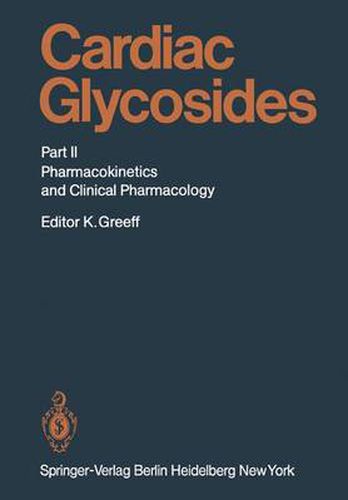Readings Newsletter
Become a Readings Member to make your shopping experience even easier.
Sign in or sign up for free!
You’re not far away from qualifying for FREE standard shipping within Australia
You’ve qualified for FREE standard shipping within Australia
The cart is loading…






This title is printed to order. This book may have been self-published. If so, we cannot guarantee the quality of the content. In the main most books will have gone through the editing process however some may not. We therefore suggest that you be aware of this before ordering this book. If in doubt check either the author or publisher’s details as we are unable to accept any returns unless they are faulty. Please contact us if you have any questions.
The pharmacokinetics of digitalis glycosides have been the subject of extensive re view (IISALO, 1977; ARONSON, 1980; PERRIER et ai., 1977). Research on glycoside kinetics has progressed at a rapid pace, requiring continuing reevaluation of the state of our understanding of this problem. The present article focuses on the effect of disease states (renal, gastrointestinal, thyroid, and cardiac) on the absorption, distribution, and clearance of a number of digitalis glycosides. Evidence is critically reviewed, and interpreted with respect to possible clinical implications. A. Renal Insufficiency I. Strophanthin Strophanthin disposition in renal failure has been evaluated in only two studies. KRAMER et ai. (1970) determined an elimination half-life of 14 h in normals as com pared to 60 h in anuric patients. Similar results were reported by BRASS and Pm LIPPS (1970) using tritiated strophanthin. They found a half-life value of 18 h in healthy individuals as compared to 68 h in anuric patients. The findings clearly in dicate that the elimination half-life of strophanthin is prolonged in renal failure.
$9.00 standard shipping within Australia
FREE standard shipping within Australia for orders over $100.00
Express & International shipping calculated at checkout
This title is printed to order. This book may have been self-published. If so, we cannot guarantee the quality of the content. In the main most books will have gone through the editing process however some may not. We therefore suggest that you be aware of this before ordering this book. If in doubt check either the author or publisher’s details as we are unable to accept any returns unless they are faulty. Please contact us if you have any questions.
The pharmacokinetics of digitalis glycosides have been the subject of extensive re view (IISALO, 1977; ARONSON, 1980; PERRIER et ai., 1977). Research on glycoside kinetics has progressed at a rapid pace, requiring continuing reevaluation of the state of our understanding of this problem. The present article focuses on the effect of disease states (renal, gastrointestinal, thyroid, and cardiac) on the absorption, distribution, and clearance of a number of digitalis glycosides. Evidence is critically reviewed, and interpreted with respect to possible clinical implications. A. Renal Insufficiency I. Strophanthin Strophanthin disposition in renal failure has been evaluated in only two studies. KRAMER et ai. (1970) determined an elimination half-life of 14 h in normals as com pared to 60 h in anuric patients. Similar results were reported by BRASS and Pm LIPPS (1970) using tritiated strophanthin. They found a half-life value of 18 h in healthy individuals as compared to 68 h in anuric patients. The findings clearly in dicate that the elimination half-life of strophanthin is prolonged in renal failure.